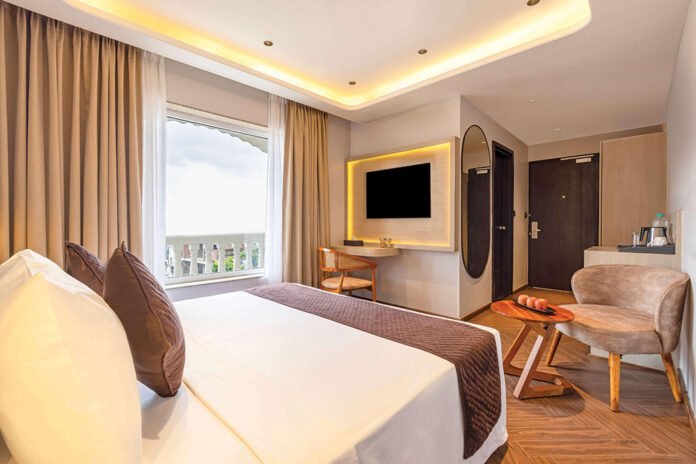Sterling Holiday Resorts’ new Sterling Rampath Ayodhya is more than a brand milestone — it is a timely strategic bet on one of India’s fastest-growing travel segments. The 35-room property, Sterling’s 11th spiritual destination and the company’s 67th hotel, opens at a moment when Ayodhya’s visitor economy is being reshaped by major infrastructure, state investment, and surging pilgrim numbers.
Culinary experiences are centered around The Divine, a pure-vegetarian, multi-cuisine restaurant that emphasizes sattvic-inspired preparations. Special Jain meal options are also available, aligning closely with the spiritual ethos of Ayodhya and its diverse visiting devotees.
Speaking at the launch, Vikram Lalvani, Managing Director & CEO, Sterling Holiday Resorts, said:
“Ayodhya is at the heart of India’s spiritual and cultural renaissance. Sterling Rampath Ayodhya is more than a hotel—it is a gateway to devotion and discovery, serving guests who arrive with faith, families, and a sense of cultural curiosity. This milestone opening also marks another significant step in our mission to deliver transformational travel experiences across India.”
Echoing this vision, Rishi Uppal, Director, Kalyan KK Hotels India Pvt. Ltd., noted:
“Ayodhya is emerging as one of India’s most important spiritual destinations. Our vision was to create a property that not only serves pilgrims with comfort and care but also honours the cultural fabric of the city. In Sterling, we found a partner who shares this vision—bringing operational depth, brand trust, and guest-centric hospitality that ensures every visitor leaves with a truly blessed experience.”
With religious tourism projected to play a key role in India’s domestic travel growth, Sterling’s strategic entry into Ayodhya positions it at the confluence of faith, culture, and hospitality. The Rampath property is poised to cater to both pilgrims seeking spiritual solace and travelers eager to engage with Ayodhya’s rich heritage.
Footfall and demand: the numbers that matter
Ayodhya’s visitor trajectory has accelerated sharply since the consecration of the Ram Mandir. Government and industry reports show a sharp rise in pilgrims: Ayodhya recorded a significant uptick in 2024, with some reports noting more than 1.6 million pilgrims that year — a jump from under 600,000 the previous year — and other government publications pointing to many millions of visitors in the months after the temple consecration. These surges have fuelled demand for mid-to-upper-market hotel inventory as families and organised pilgrim groups look for comfortable, respectful stays near the city’s principal shrines.
The scale of growth also shows in regional airport traffic: the newly inaugurated Maharshi Valmiki / Ayodhya airport moved rapidly from launch to commercial operations in early 2024 and handled more than a million passengers in FY 2024–25 — underscoring how improved air access is translating directly into more overnight visitors.
Connectivity and infrastructure: why Ayodhya is now on the national map
Two practical changes have materially altered Ayodhya’s accessibility:
• Air connectivity. The new Maharshi Valmiki International Airport (Ayodhya) — inaugurated in late December 2023 and operating regular scheduled flights from January 2024 — has shortened journey times for pilgrims from major Indian metros and enabled packaged short-stay travel. Early passenger statistics show strong year-on-year growth, signalling robust demand for nearby hotels.
• State investment and urban projects. The Uttar Pradesh government and Ayodhya development agencies have backed a string of projects — from riverfront and museum initiatives to junction and road upgrades — and budget allocations for religious and cultural programmes have underpinned a tourism-focused upgrade of civic infrastructure. These initiatives are intended to turn Ayodhya into a multi-day destination rather than a single-day pilgrimage stop.
Market context: rising room demand and investor interest
Uttar Pradesh’s push to monetise religious tourism has prompted politicians and administrators to call for significant hospitality expansion — some public comments suggest the state needs hundreds of thousands of additional rooms to meet projected demand from middle-class families and organised pilgrim flows. That creates a strong pipeline opportunity for branded midscale and upper-midscale operators such as Sterling, which can combine standardised service with culturally sensitive programming.
Real estate and destination analyses also forecast sustained interest from domestic and NRI investors, and municipal master-plans signal further commercial corridors growing along the airport and ring road, which will shape demand zones for future hotels and F&B.
What Sterling Rampath Ayodhya brings to the table
Sterling’s Rampath property is tailored to the pilgrim-cum-family traveller: compact but well-appointed rooms, a pure-vegetarian restaurant serving sattvic and Jain options, and a location designed for easy temple access. Those attributes meet three critical guest expectations in spiritual tourism: proximity, culturally appropriate F&B, and quiet, restful accommodation after darshan. The hotel’s scale — 35 rooms — allows Sterling to experiment with curated packages, day-tour tie-ups and group pricing while limiting operational complexity during the property’s initial run. (Property details as provided by the company.)
Strategic opportunities and recommendations
For Sterling and peers considering expansion in Ayodhya and comparable pilgrimage hubs, the following tactics are recommended:
- Curated pilgrimage packages. Partner with temple trusts, local guides, and transport operators to sell multi-day darshan packages that include priority darshan slots, guided heritage walks, and Saryu-river experiences. These packages increase the average length of stay and RevPAR.
- Religion-sensitive F&B programming. The Divine’s pure-veg, sattvic focus is a template — expand into curated seasonal menus tied to festivals (Deepotsav, Ram Navami) and offer pre-bookable prasadam or boxed meals for group bookings.
- Group and B2B sales. Build relationships with pilgrimage organisers, religious trusts and corporate CSR programs that sponsor group travel; offer volume pricing with guaranteed room blocks during peak festival periods.
- Experience-led content and storytelling. Use local scholarship and cultural programming to create loyalty among repeat domestic visitors — workshops on Ramayana heritage, talks by scholars, and curated photography trails.
- Flexible inventory and peak-load management. Given heavy seasonality, adopt dynamic pricing, short-term yield management, and temporary staff augmentation during festivals to protect service levels and margins.











